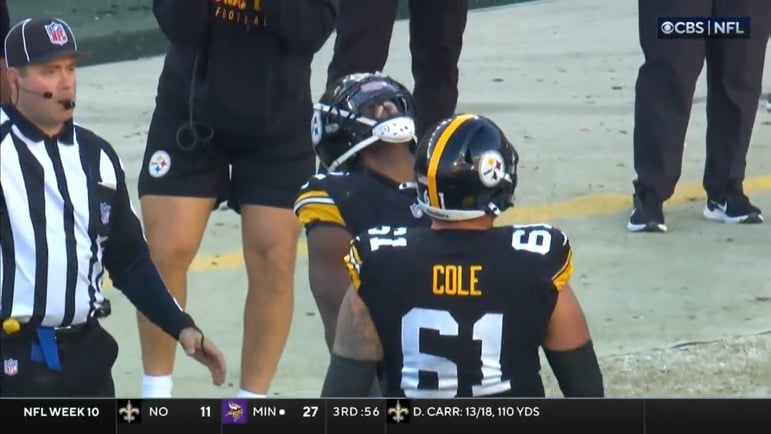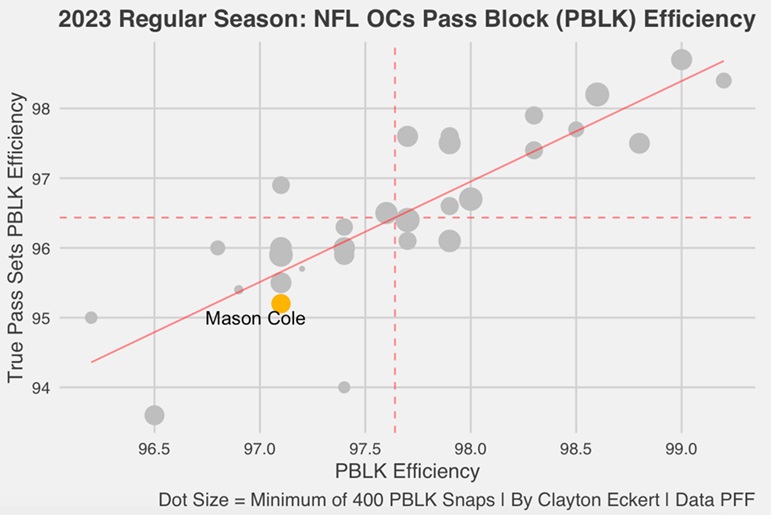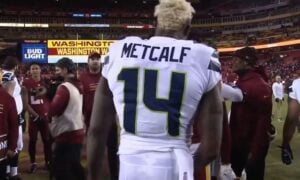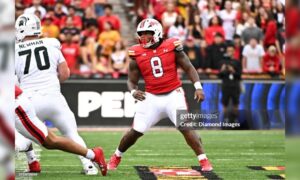Today, I wanted to continue the NFL position group series with offensive centers, looking at pass blocking data from Pro Football Focus (PFF). As opposed to their grading system that many (including myself) reference, this article will dive into their pass blocking efficiency metric.
Pass blocking efficiency measures pressure allowed on a per-snap basis with weighting towards sacks allowed. While it doesn’t tell the full story, it factors very important elements to efficient pass blockers into one number.
Let’s see how the position fared in pass block efficiency, along with the same stat in true pass sets (excludes plays with less than four rushers, play action, screens, short drop backs, and time to throw numbers under two seconds):
Here we see former Steelers center Mason Cole as the only qualifier (min. 400 PBLK snaps), landing in the undesired quadrant on the bottom left. His 97.1 PBLK efficiency tied with several of his peers at 23rd (out of 32), while his 95.2 number in true pass sets came in at 28th (fifth-worst). Both were well below the line but we see that true pass sets, the more ideal situation to produce in, was the most discouraging for Cole.
One great thing that he provided was durability, playing every regular season game in 2023. The dot sizes visualize the players pass block snaps, with Cole ranking 17th with 604. This emphasizes Pittsburgh’s run-first mentality where Cole did fare better. But it’s a passing league and it all starts up front.
Here are Cole’s more specific totals that contribute to the pass block efficiency data points:
Totals: 31 pressures (29th), 24 hurries (T-30th), five QB hits (T-24th), two sacks allowed (T-tenth).
True Pass Sets: 27 pressures (T-31st), 21 hurries (32nd, dead last), five QB hits (T-29th), two sacks allowed (T-14th).
What really jumps out are the dips across the board in true pass sets, including all of the QB hits and sacks allowing coming in those situations that should lean in the favor of offensive lineman. The charting is of course subjective on these stats, personally thinking that even more could have been charged to Cole’s name, so it was clear an upgrade was warranted for the 2024 season.
That investment was made in the 2024 NFL draft, selecting Zach Frazier in the second round. In a blocking stat study on Frazier I did for his final 2023 college season, the findings emphasized impressive feats as a run blocker while pass blocking was an area to improve on as well.
While I know that the college game is a different animal than the NFL, here are Frazier’s numbers in his final 2023 season with West Virginia:
Totals: six pressures, three hurries, three QB hits, no sacks allowed, 99.1 PBLK efficiency.
True Pass Sets: four pressures, one hurry, no QB hits, no sacks allowed, 97.9 PBLK efficiency.
Yes, Frazier did suffer a leg injury that showed valiant hearts and smarts that Pittsburgh surely loved, coming late in the season finale. He showed great durability in the rest of his college career, so knock-on-wood he continues that with the Black and Gold.
It is important to note that the college regular season is 12 games, compared to the NFL’s 17 games, so the totals aren’t meant to be a one-to-one comparison to Cole.
We do see encouraging marks though, starting with no sacks allowed. Also encouraging are his stronger PBLK efficiency numbers, and producing more when expected in true pass sets. In that situation, he also had no QB hits allowed, to pair impressively with not giving up a sack.
That is all encouraging, and hopefully translates to the NFL his rookie year (and beyond). So, the hope is the investment in the center position provides noticeable dividends, getting similar durability as Pittsburgh had with Cole in 2023. But, here’s to hoping the quality looks vastly different, keeping the new QB room that has a history of holding onto the football and taking sacks cleaner in 2024.









